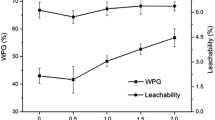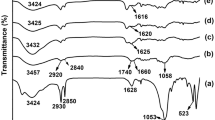Abstract
Wood polymer nanocomposites (WPNCs) based on simul wood (Bombex ceiba, L.) were prepared by impregnation of styrene acrylonitrile copolymer, γ-methacryloyloxy trimethyl silane-modified TiO2, SiO2 nanoparticles and nanoclay intercalating mixture through vacuum impregnation. The impact of nanofillers on the physical properties, flame retardancy, water resistance, anti-swelling efficiency and biodegradability of the resultant WPNCs was investigated. Remarkable enhancement in wood properties such as flame retardancy, water resistance and anti-swelling efficiency was achieved with the treatment. The results showed that all the properties were maximum for wood samples treated with SAN/TiO2 (0.5 %)/SiO2 (0.5 %)/nanoclay (0.5 %). The presence of TiO2 nanoparticles in WPNC exhibited antibacterial activity. The resistance to biodegradation was observed by incorporation of nanofillers into wood.






Similar content being viewed by others
References
Ashori A, Nourbakhsh A (2011) Preparation and characterization of polypropylene/wood flour/nanoclay composites. Eur J Wood Prod 69(4):663–666
Behzad HM, Ashori A, Tarmian A, Tajvidi M (2012) Impact of wood preservative treatments on some physico-mechanical properties of wood flour/polyethylene composites. Constr Build Mater 35(10):246–250
Bordes P, Pollet E, Averous L (2009) Nano-biocomposites: biodegradable polyester/nanoclay systems. Prog Polym Sci 34:125–155
Cai X, Riedl B, Zhang SY, Wan H (2008) The impact of nature of nanofillers on the performance of wood polymer nanocomposites. Composites: Part A 39:727–737
Camino G, Tartagilione G, Frache A, Manferti C, Costa G (2005) Thermal and combustion behaviour of layered silicate–epoxy nanocomposites. Polym Degrad Stab 90:354–362
Chen Y, Lin A, Gan F (2006) Improvement of polyacrylate coating by filling modified nano-TiO2. Appl Surf Sci 252:8635–8640
Clausen CA, Kartal SN, Arango RA, Green F (2011) The role of particle size of particulate nano-zinc oxide wood preservatives on termite mortality and leach resistance. Nanoscale Res Lett 6:427
Clemon C (2002) Wood-plastic composites in the United States. The interfacing of two industries. Forest Prod J 52(16):10–18
Devi RR, Maji TK (2011) Physical properties of simul (red-silk cotton)-wood (Bombax ceiba L.) chemically modified with styrene-acrylonitrile co-polymer and nanoclay. Holzforschung 66(3):365–371
Devi RR, Maji TK (2012a) Chemical modification of simul wood with styrene–acrylonitrile copolymer and organically modified nanoclay. Wood Sci Technol 46:299–315
Devi RR, Maji TK (2012b) Study on properties of simul wood (Bombax ceiba L.) impregnated with styrene acrylonitrile copolymer, TiO2, and nanoclay. Polym Bull 69:105–123
Fujishima A, Rao TN, Tryk DN (2000) Titanium dioxide photocatalysis. J Photobiol Photochem Rev 1:1–21
Hamzeh Y, Ashori A, Marvast EH, Rashedi K, Mohammad Olfat A (2012) A comparative study on the effects of Coriolus versicolor on properties of HDPE/wood flour/paper sludge composites. Compos B 43(5):2409–2414
Hon DNS (1991) Photochemistry of wood. In: Hon DNS, Shiraishi N (eds) Wood and cellulosic chemistry. Marcel Dekker, New York, pp 525–555
Hua D, Cheuk K, Wei-ning Z, Chen W, Chang-fa X (2007) Low temperature preparation of nano TiO2 and its application as antibacterial agents. Trans Nonferrous Met Soc China 17:700–703
Jonathan SG, Fasidi IO, Ajayi AO, Adegeye A (2008) Biodegradation of Nigerian wood wastes by Pleurotus tuber-regium (Fries) Singer. Bioresour Technol 99:807–811
Kersten P, Cullen D (2007) Extracellular oxidative systems of the lignin-degrading Basidiomycete Phanerochaete chrysosporium. Fungal Genet Biol 44:77–87
Li J, Yu H, Sun Q, Liu Y, Cui Y, Lu Y (2010) Growth of TiO2 coating on wood surface using controlled hydrothermal method at low temperatures. Appl Surf Sci 256:5046–5050
Li Y, Dong X, Liu Y, Li J, Wang F (2011) Improvement of dimensional stability of wood via combination treatment: swelling with maleic anhydride and grafting with glycidyl methacrylate and methyl methacrylate. Int Biodeterior Biodegrad 65:1087–1094
Liu D, Padias AB, Hall HK Jr (1995) On the Thermal Co-Polymerization of Styrene with Acrylonitrile. Macromolecules 28(2):622–626
Mahltig B, Swaboda C, Roessler A, Bottcher H (2008) Functionalising wood by nanosol application. J Mater Chem 18:3180–3192
Matsunaga T, Tomoda R, Nakajima Y, Nakamura N, Komine T (1988) Continuous-sterilization system that uses photosemiconductor powders. Appl Environ Microbiol 54:1330–1333
Minelli M, Angelis MGD, Doghieri F, Rocchetti M, Montenero A (2010) Barrier properties of organic–inorganic hybrid coatings based on polyvinyl alcohol with improved water resistance. Polym Eng Sci 50:144–153
Nourbakhsh A, Baghlani FF, Ashori A (2011) Nano-SiO2 filled rice husk/polypropylene composites: physico-mechanical properties. Ind Crops Prod 33(1):183–187
Panov D, Terziev N (2009) Study on some alkoxysilanes used for hydrophobation and protection of wood against decay. Int Biodeterior Biodegrad 63(4):456–461
Perez C, Paul M, Bazerque P (1990) Antibiotic assay by agar-well diffusion method. Acta Biol Med Exp 15:113–115
Sereshti H, Rovshandeh JM (2003) Chemical modification of beech wood. Iran Polym J 12:15–20
Sheshmani S, Ashori A, Farhani F (2012) Effects of extractives on the performance properties of wood flour-polypropylene composites. Appl Polym Sci 123(3):1563–1567
Stolf DO, Rocco Lah FA (2004) Wood-polymer composite: physical and mechanical properties of some wood species impregnated with styrene and methyl methacrylate. Mater Res 7(4):611–617
Sun Q, Lu Y, Liu Y (2011) Growth of hydrophobic TiO2 on wood surface using a hydrothermal method. J Mater Sci 46(42):7706–7712
Vassiliou AA, Bikiaris D, El Mabrouk K, Kontopoulou M (2011) Effect of evolved interactions in poly(butylene succinate)/fumed silica biodegradable in situ prepared nanocomposites on molecular weight, material properties and biodegradability. J Appl Polym Sci 119(4):2010–2024
Zhao G, Lu WH (2008) Structure and characterization of Chinese fir (Cunninghamia lanceolata) wood/MMT intercalation nanocomposite (WMNC). Front For China 3(1):121–126
Acknowledgments
One of the authors Rashmi R. Devi would like to express gratitude and thanks to Council for Scientific and Industrial Research, India, for financial support in the form of Senior Research Fellowship (Grant in aid for CSIR No. 09/796/(0037)/2012/EMR-1).
Conflict of interest
The authors declare that they have no conflict of interest.
Author information
Authors and Affiliations
Corresponding author
Rights and permissions
About this article
Cite this article
Devi, R.R., Maji, T.K. Effect of nanofillers on flame retardancy, chemical resistance, antibacterial properties and biodegradation of wood/styrene acrylonitrile co-polymer composites. Wood Sci Technol 47, 1135–1152 (2013). https://doi.org/10.1007/s00226-013-0563-6
Received:
Published:
Issue Date:
DOI: https://doi.org/10.1007/s00226-013-0563-6




